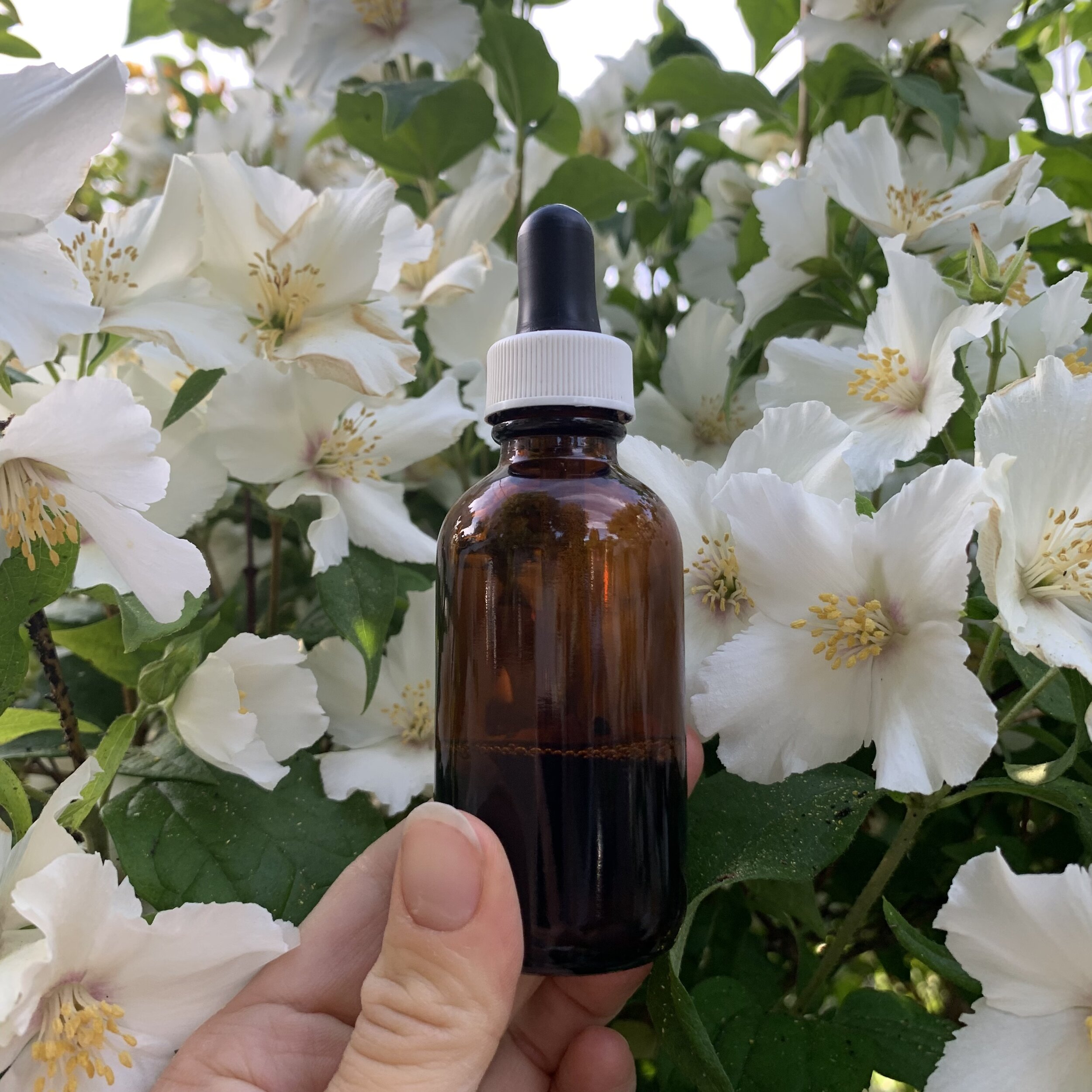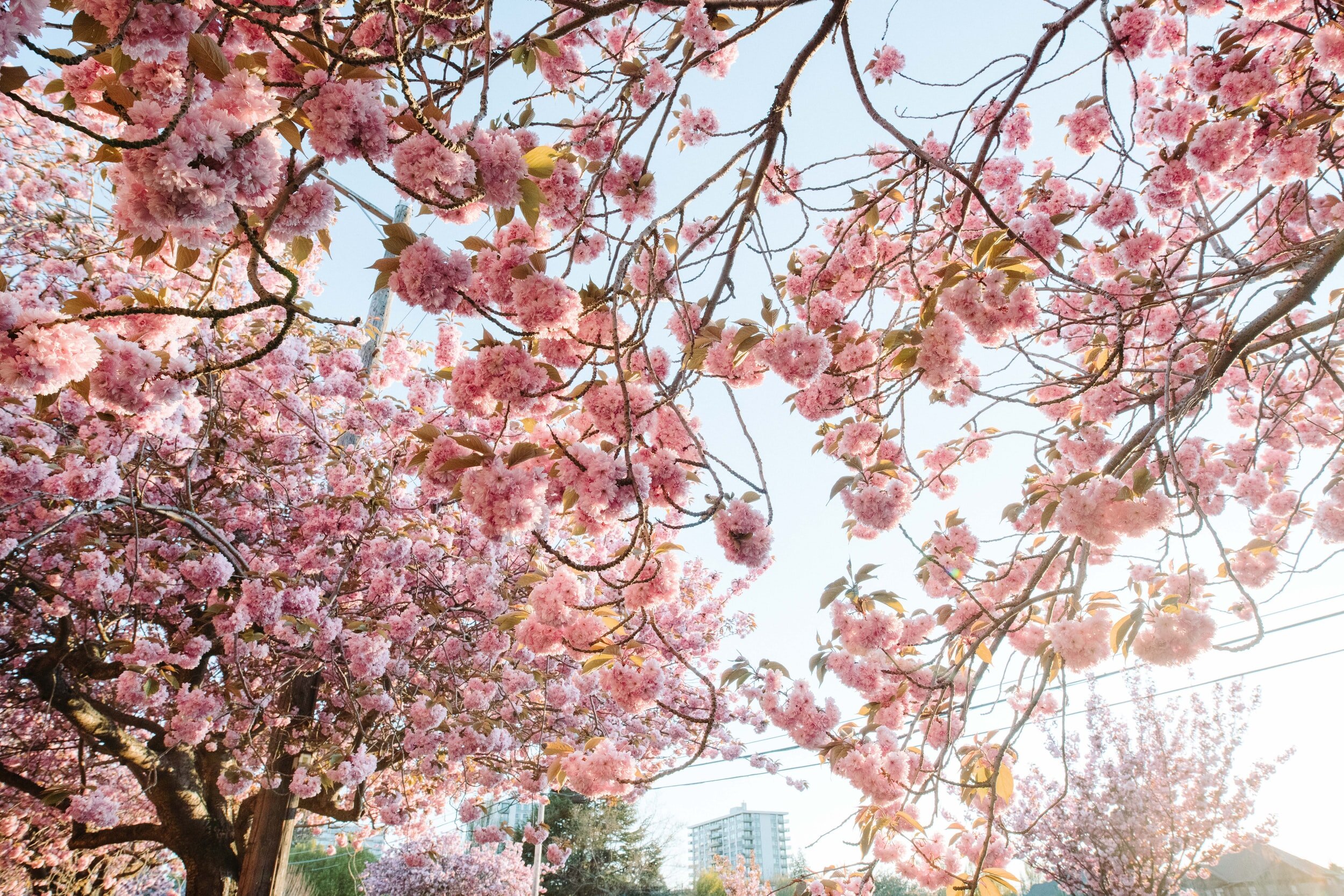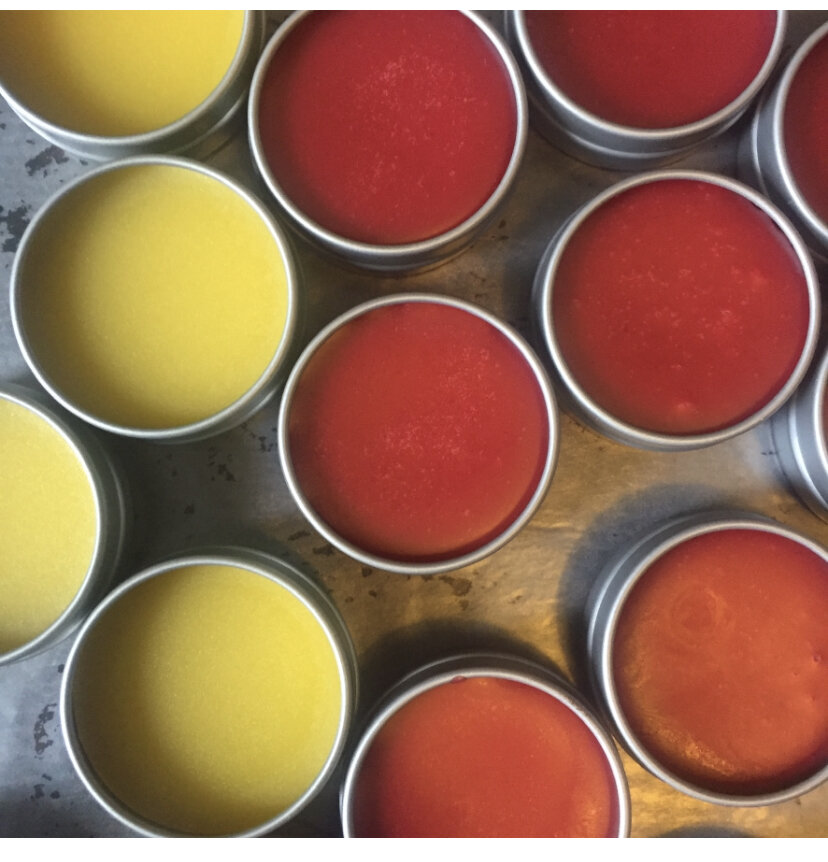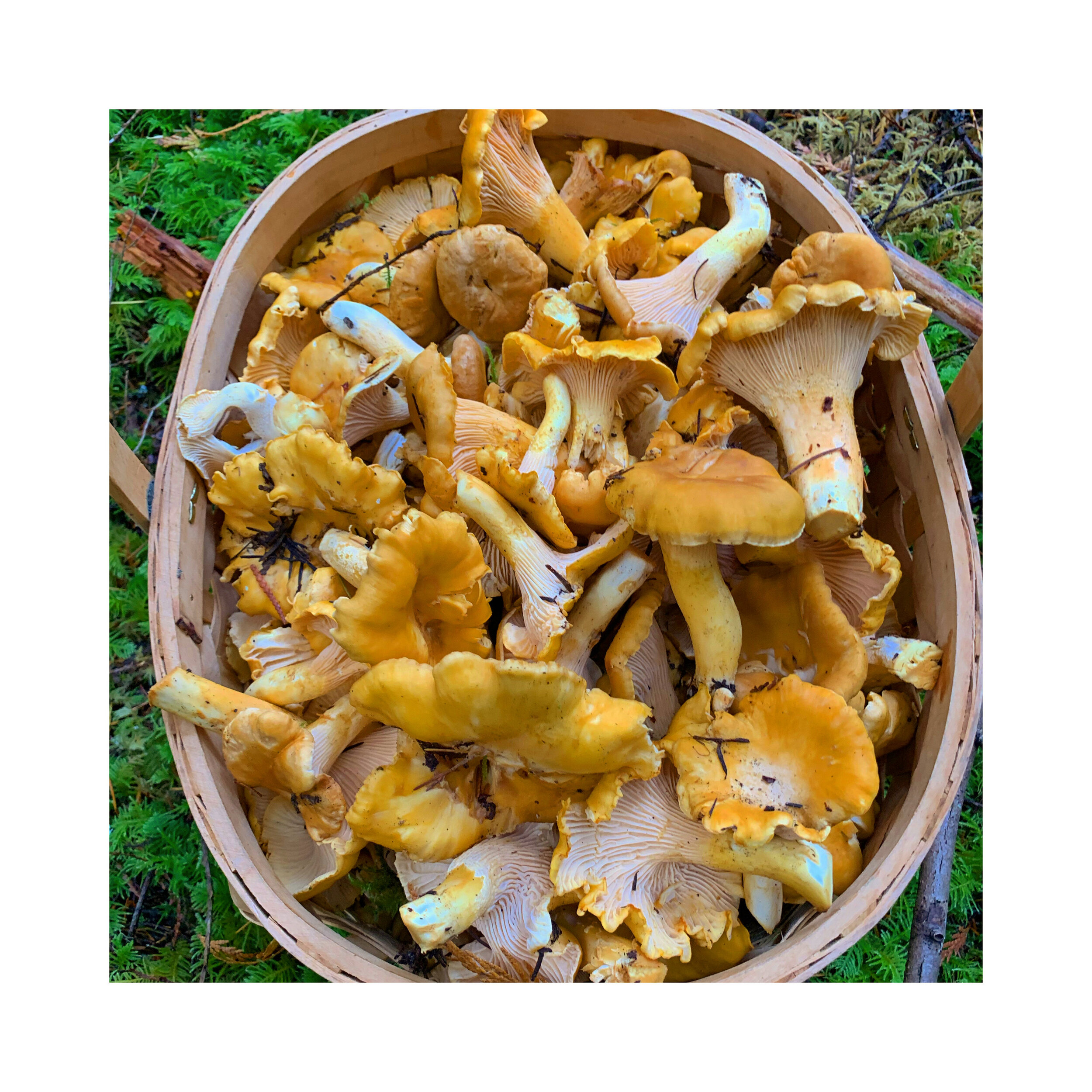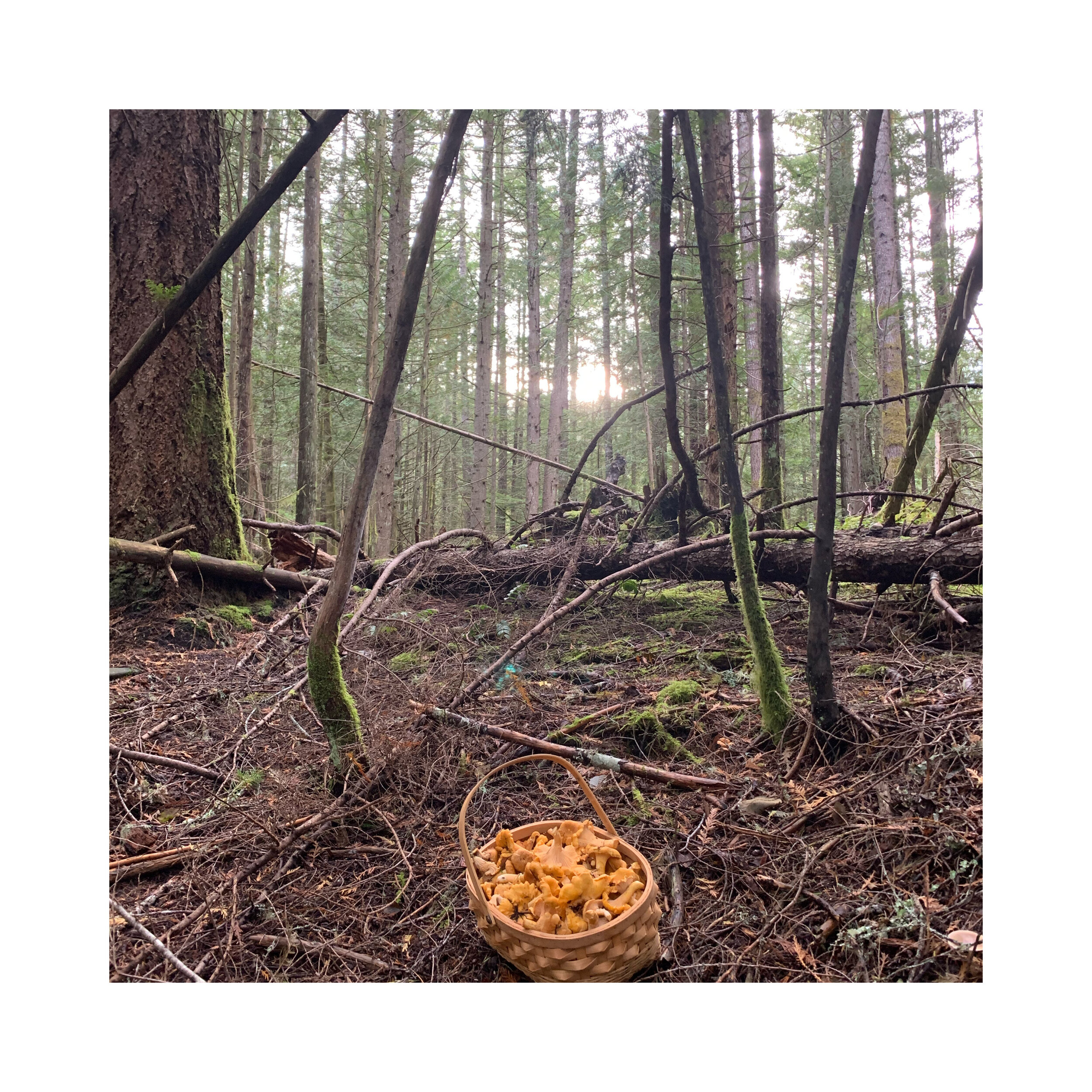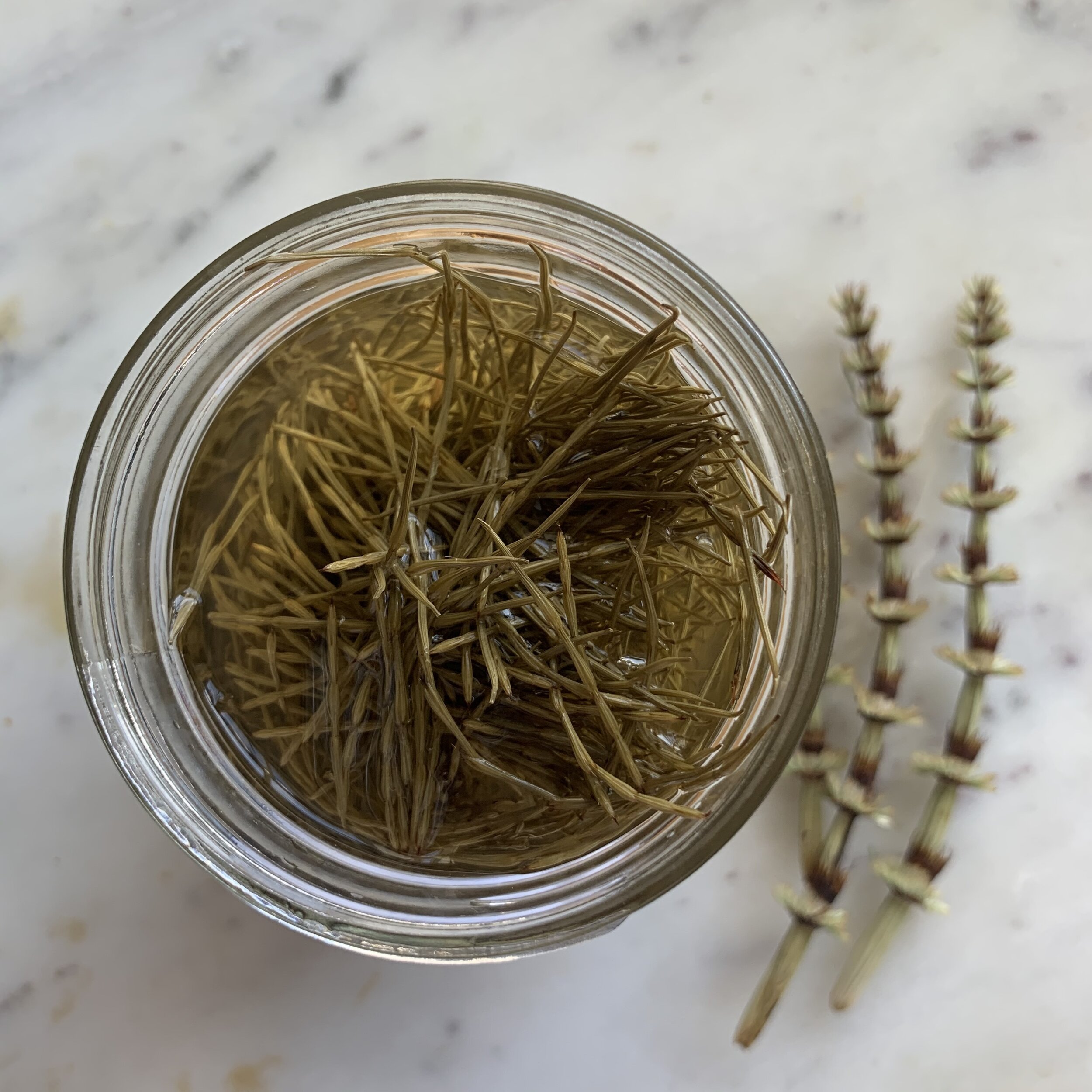This is Solstice wort harvested from the community gardens. Otherwise known as St. Johns Wort, blooming with the solstice at the height of summer, it’s used to support a solemn type of depression and melancholy. Indicated for when it feels like the light is out of reach. This plant carries so much light it causes photosensitivity in the skin of the user. It moves the liver quite strongly and carries contraindications with pharmaceuticals so I often work with it internally in drop doses for the energetics of the plant versus therapeutic doses. Solstice wort infuses nicely into oils turning them a deep vibrant red, which is soothing for aches, nerve pain and skin healing as well as self massage during the colder months when we need a reminder of the sun on our skin. You can find directions for making an infused oil here.
DIY Catnip Herbal Bug Spray
I got some fresh locally grown catnip to make some herbal insect repellent as the mosquitoes seems to be after me this year. There’s been quite a few studies showing that catnip extract is more effective than deet in repelling mosquitos. There’s a few ways of using catnip for repelling insects - rubbing fresh leaves on your skin, using catnip essential oil or making a fresh plant spray:
Cat Nip Bug Spray
* fill a mason jar half full of freshly chopped and macerated leaves and stems, cover to the top with clear alcohol - such as vodka or high proof rubbing alcohol for a cost effective option.
* Cover and let sit for 7 days. Strain out liquid with cheesecloth and squeeze well to strain excess alcohol from plant material.
* Mix your newly green alcohol 3 parts catnip to 1 part aloe Vera gel. Optional: 20 drops citronella essential oil. If your spray is too drying on your skin you can add some rose water to dilute it.
* Store in a spray bottle and spray liberally as you would regular insect repellent.
* Beware if you have a cat they will be after you when you wear this.
Elixir Recipe for Emotional Support
Elixirs use honey and a menstruum of either alcohol such as brandy or ACV for those alcohol free to extract the therapeutic properties of plants. Because of the sweetness of the honey and more delicate flavours extracted, which both open the heart, I often turn to élixirs when I want the energetic, spiritual and emotional support of the plants versus the medical indications. Depending on the plants used, élixirs can be helpful for grounding, anxiety, depression, grief, soothing anger and rage, supporting fatigue that comes from emotional/ trauma processing and uplifting the spirit in heavy times.
A medicine that feels very appropriate for these times as we move through cultural trauma, indigenous reconciliation, and re-emerge into a post-pandemic social world.
Some plants blooming now that can be used in elixirs:
-rose
-lavender
-chamomile
-lemon balm
-st john’s wort
-yarrow
-Tulsi
-hawthorn berry (in late summer)
Dried plants can also be used in this recipe if fresh plants aren’t available to you.
How to make an elixir:
Fill a mason jar 3/4 full of fresh plants or half full of dried plants. Add 1/4 honey (raw/local if possible) and fill to the top with your alcohol or apple cider vinegar. Stir well and seal jar. Store in a cool dark place for 2-3 weeks, giving a good shake when you remember. Strain off plant material with some cheesecloth and squeeze out all the liquid. Add more honey to taste if you prefer and store in glass dropper bottles. .
Eating Your Weeds
It’s the time of year when all the greens are springing from the earth, making themselves available to our sluggish winter bodies. Many common “weeds” in Victoria are in fact edible and highly nutritious wild greens. In TCM these wild greens clear toxins, benefit the liver and cool stagnant heat. Below are my favorite edible “weeds” + a few recipes to enjoy them.
Miners Lettuce - Claytonia perfoliata - miners lettuce is a common ground cover crop, used as a nitrogen fixer in many community gardens & permaculture sites, though it is a native species that grows wild at the edges of parks, forests and seaside cliffs. It has a taste and texture similar to spinach. Sometimes referred to as winter purslane it got its common name Miners Lettuce from stories of gold rush miners eating it to stave of scurvy. Thus you might have guessed it’s high in vitamin C. Tasty eaten fresh in salads or loaded into this recipe for green soup.
Chickweed - Stellaria media - A member of the carnation family, chickweed has beautiful tiny white flowers which are edible along with its leaves and stems. An introduced species that has thrived in this climate, you will find her in forests, over grown gardens and along parking lot edges. She packs a punch for a tiny weed with calcium, magnesium and (I just learned) 83x more iron than spinach! I’ve also heard stories of chickweed being used an an anti-inflammatory, as well as for skin and digestive health. You can enjoy Chickweed raw in salad, infuse into a vinegar, or pulse into a paste in a food processor and freeze for a boost in the colder months.
Dandelion - Taraxacum officinale - Ol’ faithful weed, beloved of the honeybees, if you can avoid mowing her please do! Leaf, flower and root are all edible. The leaves are known as Pu Gong Ying in the TCM herbal canon - which are used to clear heat, dissipate nodules, detox, & promote lactation. Too bitter for me in salads but quite nice in wild pestos. The flowers have a ton of pollen and wild yeast which infuse well into vinegar, wild sodas and mead. The roots are used as liver medicine - but if you can wait until later in the summer and early fall when the energy descends back into the earth they will be even more potent. I like to use the roots for making these spiced bitters in the fall.
Edible Cherry & Plum Blossom
Plum and Cherry blossoms are once again gracing the streets of Victoria. A very welcome sight of spring after the hard winter we’ve all had. Part of the Prunus family with other stone fruits like peaches and nectarines they have delicate sweet edible flowers. Both cherry and plum blossoms have cultural significance in East Asia (where acupuncture originates) though neither of them are listed in the TCM herbal canon. Instead they are enjoyed in cooking, salted for teas and adored by the masses at flower viewing parties in the park.
Plum happens to be my preferred blossom of the two for its strong aromatic almond-like scent and taste. They are lovely infused into vinegar, cordials or liqueurs, fermented into honey or mead, pulsed into sugar for baking & icing or for topping cakes and decorating cookies. All beautiful ways of preserving these first fleeting moments of spring.
plum blossom - round petal, dark leaves
cherry blossom - notched petal, flower clusters
Holistic Breast Care - Lymphatic Breast & Chest Oil
Breast & lymph care is an often overlooked part of our holistic health. Breasts are important organs that contain a large amount of blood vessels, nerves and lymph ducts. Breast tissue can accumulate toxins over time as the body stores waste in adipose tissue and lymphatic system gets sluggish with environmental toxins. (I remember being at a lecture with David Suzuki years ago who said the environmental health of a population can be seen in the health of mammal breast tissue. )
In TCM our breasts have 3 major organ meridians passing through them - stomach, liver and kidney. Many common breast ailments can be due to a disharmony or blockage of energy in these channels.
Further, breasts and surrounding areas like the clavicle, neck and armpits contain a large amount of lymph nodes and vessels.
What is the lymphatic system?:
The lymphatic system is a circulatory system made up of lymph vessels, which are much like blood vessels. It drains extra fluid (called lymph) that has passed out of the blood and into tissues and returns it back to the blood.
Lymph is a clear fluid that contains lymphocytes, a type of white blood cell that fights germs, foreign substances and abnormal cells, like cancer cells. Lymph also has macrophages, another type of white blood cell that helps fight infection. Lymph collects some waste products, bacteria and damaged cells from inside the body’s tissues so that they can be removed from the body or destroyed. Lymph drains into lymph vessels that carry it to lymph nodes. Lymph nodes clean the lymph and add more lymphocytes to it. - cancer.ca
My favourite way to incorporate lymph & breast care is by using herbal infused oils for self massage. Though, any hands on stimulation can he helpful for supporting breast tissue and lymph movement - even if its just with your regular body lotion. I prefer to use herbs that have anti-inflammatory properties and that help with lymph movement and drainage.
This recipe for lymph & breast oil can be used for:
pain, infection, inflammation of lymph or mammary tissue
pms & menses breast tenderness
fibrocystic breasts & cysts
mastitis
lymph drainage & seasonal support
scar tissue break up esp. after mastectomy & lumpectomy in cases of cancer & gender affirming surgeries
self checking & early detection of breast cancer
grounding, soothing & pleasure
Ingredients:
1 cup carrier oil - such as olive, grape seed, or hemp
1 cup castor oil
1/2 cup dried calendula (lymph inflammation)
4 tbsp dried cleavers (lymph draining & tissue detox)
4 tbsp dried red clover (lymph and blood mover)
*** red clover is a phytoestrogen and should be avoided & omitted in cases of breast cancer.
optional: lavender essential oils
How to make breast/chest oil:
Combine dried herbs and oil in a glass mason jar and stir well. Cover with lid and let the oil infuse in a sunny spot for 2-4 weeks. Strain with a cheese cloth and squeeze excess oil from herbs. Add essential oils if using. Store infused oil in a glass bottle away from direct sunlight.
How to use breast/chest oil:
Apply liberally to breasts & chest area, arm pits, neck and collar bones. Massage at a pressure that feels soothing and comfortable along the drainage flow as illustrated below. Gua sha tools can be used for added support, especially along the neck and collar bones.
*Again, this massage can be done without herbal oil for gentle lymph and breast health. The important thing is to get stimulation and movement in the tissues.
Simplified lymph drainage flow chart
If you have breasts this can also be a good opportunity to get to know what your tissue feels like and incorporate regular self checks for breast cancer. Below are the three recommended patting motions for checking breast tissue along with a how to of the five steps. For more info see here.
How to do a breast self-exam: The five steps
Step 1: Begin by looking at your breasts in the mirror with your shoulders straight and your arms on your hips.
Here's what you should look for:
Breasts that are their usual size, shape, and color
Breasts that are evenly shaped without visible distortion or swelling
If you see any of the following changes, bring them to your doctor's attention:
Dimpling, puckering, or bulging of the skin
A nipple that has changed position or an inverted nipple (pushed inward instead of sticking out)
Redness, soreness, rash, or swelling
Step 2: Now, raise your arms and look for the same changes.
Step 3: While you're at the mirror, look for any signs of fluid coming out of one or both nipples (this could be a watery, milky, or yellow fluid or blood).
Step 4: Next, feel your breasts while lying down, using your right hand to feel your left breast and then your left hand to feel your right breast. Use a firm, smooth touch with the first few finger pads of your hand, keeping the fingers flat and together. Use a circular motion, about the size of a quarter.
Cover the entire breast from top to bottom, side to side — from your collarbone to the top of your abdomen, and from your armpit to your cleavage.
Follow a pattern to be sure that you cover the whole breast. You can begin at the nipple, moving in larger and larger circles until you reach the outer edge of the breast. You can also move your fingers up and down vertically, in rows, as if you were mowing a lawn. This up-and-down approach seems to work best for most women. Be sure to feel all the tissue from the front to the back of your breasts: for the skin and tissue just beneath, use light pressure; use medium pressure for tissue in the middle of your breasts; use firm pressure for the deep tissue in the back. When you've reached the deep tissue, you should be able to feel down to your ribcage.
Step 5: Finally, feel your breasts while you are standing or sitting. Many women find that the easiest way to feel their breasts is when their skin is wet and slippery, so they like to do this step in the shower. Cover your entire breast, using the same hand movements described in step 4.
Coastal Mugwort Womb & Hara Oil
Coastal mugwort is an abundant beauty along our shore lines with silver downy under-leaf and a rich aromatic smell. Part of the Artemisia family - along with sagewort and wormwood, they get their name sake from Artemis - Goddess of the Moon who was the patron of the herbalist, the midwife, the birthing woman, and the hunter. So it’s no surprise that mugworts have a rich pan cultural history of being used for menstrual health, womb healing, dreamwork and as a replenishing tonic.
Mugworts are especially dear to me as an acupuncturist because it is the herb from which Moxa is made for moxibustion. Moxa is burned on the skin to replenish Qi, stimulate acupuncture channels and counter balance ‘cold & damp’ conditions in the body. If you have ever had a session with me - you have already worked with mugwort.
I’ve made several versions of this womb oil. Some with devils club, some with CBD, with castor oil and without - but always a base of mugwort infused oil. Feel free to make additions to this recipe that feel good for your body. If you don’t feel confident foraging mugwort, you can always buy some from a local herb shop instead.
Womb oil is used topically on the pelvis and abdomen to increase circulation, ease cramps, and provide grounding ritual. You can use oil at any point in your cycle, however mugwort is not recommended during pregnancy or for those trying to conceive.
To use womb oil: apply liberally to pelvis and womb area, cover with a warm towel and place a hot water bottle, heat pack or warm womb rock on top. Use this time to rest deeply.
Ingredients:
Mugwort - dried* & cut into small pieces - approx 1 cup
1 cup carrier oil- I use olive or grape seed
1 cup castor oil
500 ml glass mason jar
Optional: Lavender essential oils
Instructions:
Make an infused oil by adding your dried herbs to the jar and covering with oil.
Stir to make sure herbs are completely saturated and close the lid tightly.
Let infuse in a sunny window for 2-4 weeks.
Strain off herbs through mesh or cheesecloth. Make sure to squeeze out excess oil from your herbs. Add essential oil if using.
Store infused oil in glass container away from direct sunlight.
**Note it is important to use dried herbs as moisture can turn oils rancid. If you forage your mugwort try hanging it in bundles to dry in your room or bedside for its ancient use of enhancing dreams.
Shiunko Salve & Oil
Shiunko is a Kampo (Japanese herbal medicine) formula used commonly to protect the skin during moxabustion. If you have ever had a session with me, I have definitely used it on you. It is named “burn cream” for its efficacy in healing skin from burns but also eczema, psoriasis, cuts, scraps and so on. I use it as my cure-all for all skin complaints at home. There’s been some study on its effects on cell regeneration in the dermis - you can read more here if you are interested.
The recipe is quite simple. You make an infused oil with sesame oil and two herbs - Dang Gui (angelica root) and Zi Cao Gen (Lithospermum root, aka Gromwell). Then harden into a salve with beeswax. Though, if you are using it for larger skin conditions like eczema, you can skip the wax and liberally apply the oil directly on skin after bathing.
You can find these herbs at most TCM dispensaries. I shop at Fu Hing Hong or K&A in town.
Shiunko Recipe
40 g Dang Gui
40 g Zi Cao Gen
500 ml sesame oil
Bees wax pellets
Glass jar for infusing oil and small salve jars or tins.
Directions: Make an infused oil by adding chopped herbs into glass jar and covering to the top with sesame oil. Place in a warm sunny spot to infuse for 2-3 weeks. The oil should turn a deep red color. Strain off herbs and measure your oil. To make a salve you will want a ratio of 1 part beeswax to 4 parts oil (So for 500ml oil it will be about 125ml wax). In a saucepan combine oil & wax on very low heat - melt slowly until well combined. Then pour into your jars or tins to set.
Tips:
-Make sure no water gets into your infused oil as this could cause it to spoil.
-Keep heat very low, as to not denature the oil.
-You can test the consistency of your salve by dipping a spoon in the melted wax & oil and putting it in the freezer to set quickly. If the salve is too hard, add more oil. If its too soft, add more wax.
-You can repurpose your oily herbs into body scrubs, bath salts or straight into your bath water.
-For more info on salves visit here.
Herbal Oxymel
Oxymels use honey and vinegar to extract the medicinal properties of herbs. They are generally a tastier way to take herbal extracts, with additional benefits of heart soothing honey and gut healthy apple cider vinegar. This is also a great way to introduce botanical medicine to those who don’t tolerate alcohol - such as children and those in recovery. There are a few ways to make oxymels. One way is to make an infused honey and an herbal vinegar and then combine the two. This is a good option if you want to play with your proportions of honey to vinegar or want to use the infused ingredients separately for other recipes. A simple modification is just to do a 1:1 ratio of honey to vinegar in the same preparation. My favourite herb to use is wild roses but there are many herbs that make great oxymels such as hawthorn blossom, elderberry, nettle, tulsi, elecampane, devils club, hibiscus, and lemon balm.
Herbal Oxymel
Glass quart jar with plastic lid (or parchment paper to protect metal lid from vinegar)
Herbs of choice
Equal parts raw local honey ( I use Babes honey) and unfiltered apple cider vinegar.
How to:
Fill jar 1/2 full with herbs
Cover to the top with equal parts honey and vinegar
Stir well and cover with lid
Let sit for at least two weeks, shaking occasionally
Strain off herbs, making sure to squeeze excess liquid from the herbs
Take by the dropper full medicinally, by the ounce as an aperitif, or add to sparkling water for an herbal soda.
Dandelion Root Bitters
Bitters have a long historical use as an herbal digestive aid after meals. The bitter herbs used (where it gets its name from) are known to stimulate the liver to produce bile which helps break down fatty foods. Nowadays there are popular for enhancing the flavour profile of cocktails, sodas and shrubs.
Dandelion greens are famously picked in the spring for there similar liver supporting properties. However the roots are best harvested in the fall when the energy of the plant decends back into the earth. I made these dandelion bitters generously spiced to enjoy over the holidays for some seasonal herbal support.
Dandelion Bitters
Ingredients:
Glass quart sized mason jar
Clear high proof spirit like vodka or white rum (apple cider vinegar could be used alternatively if you don’t take alcohol)
3/4 cup chopped fresh dandelion root or 1/2 cup dried
1tsp each: dried lemon peel, dried orange peel, whole clove, whole anise, whole allspice, 1/2 inch crushed cinnamon stick
2 chopped dates and/or 1 tbsp goji berries
Directions:
Add all ingredients to quart jar and cover to the top with spirits. Let sit for 2-4 weeks shaking occasionally. Strain off herbs and store bitters in dropper bottles.
Chantrelle Liqueur
Herbal liqueurs are a nice way to make special and celebratory drinks to mark occasions or give as gifts. I made this chanterelle one in the fall to give as Solstice & Christmas gifts to loved ones. The premise is simple albeit time consuming. It involves making a simple cordial syrup and an infused alcohol and then mixing them approximately 1:1 according to your sweetness preference. These chanterelles made a beautiful golden hued liqueur, thats warm and earthy. It’s well past chanterelle season but this recipe can be altered to many different herbs and flavour profiles + it’s especially fun to use whats in season around you.
Chantrelle Liqueur
Ingredients:
2-3 cups chanterelles
2 glass quart mason jars
Clear alcohol spirit such as vodka, rum or brandy
2 cups sugar or natural sweeter - I love to use honey for these.
Optional: 1/2 tsp pure vanilla or 1 vanilla pod, orange peel, 1/4 inch cinnamon stick
Directions:
First make your alcohol infusion. Fill a mason jar 2/3 full of chanterelles and top with alcohol. Let sit for minimum two weeks to extract. Strain off mushrooms and set aside.
To make cordial: bring one quart of water, vanilla, spices and 1-2 cups chanterelles to a simmer for 10-15 mins. Turn down heat and add sugar or honey. Combine well and let sit over night. Strain off mushrooms and herbs.
Combine infused alcohol and cordial at a ratio of 1:1 or to desired sweetness. Store in airtight bottles.
Repurposed Christmas Tree Household Cleaner & Hand Sanitizer
Repurposing your Christmas tree and decorations before you recycle them it is a nice way to honour the tree and extend its scents and presence in your life. Personally I don’t bring a tree into my home but I do like making these recipes this time of year to bring the vitality of the forest inside. I also like to include additional evergreen and herbaceous plants to these recipes for their ritual cleansing and protective elements in my space. Evergreens are rich in volatile oils that give them that strong aromatic scent. These oils are also naturally antimicrobial and antibacterial making them a useful addition to toxin free cleaning products.
All Purpose Household Cleaner
Ingredients:
One litre glass mason jar
peice of wax paper, cloth or beeswax wrap for the lid
White Vinegar
Several bows and branches of your Christmas tree or other evergreen.
Optional: other ritual & aromatic greenery such as rosemary, thyme, pines, firs, cedars, hemlocks, and spruces.
Essential oils of your choosing
Lemon or citrus peel - like those dehydrated orange garlands/ornaments
Instructions:
Chop or cut your greenery into 1/2 inch pieces. I like to include the stems for the additional volatile oils and resins but you can also remove the needles from the stems instead.
Fill your mason jar until 3/4 full.
Add your essential oils and citrus peel if using.
Fill to the top with vinegar and cover with a piece of cloth, wax paper or beeswax wrap before adding metal lid. (vinegar with corrode the metal lid)
Let sit for 2-3 weeks. Strain off plant matter and store the infused vinegar in a spray bottle for cleaning.
Hand sanitizer
Ingredients:
One quart glass mason jar
Rubbing alcohol
Several bows and branches of your Christmas tree or other evergreens.
Pure aloe gel
Optional: Essential oils of your choosing.
Herbs like: whole cloves, cinnamon stick,
Citrus peel - like those dehydrated orange garlands/ornaments
Instructions:
Chop or cut your greenery into 1/2 inch pieces. I like to include the stems for the additional volatile oils and resins but you can also remove the needles from the stems instead.
Fill your mason jar until 3/4 full.
Add your essential oils, herbs and citrus peel if using.
Fill to the top with rubbing alcohol. Let sit for 2-3 weeks.
Strain off plant matter and mix 2 parts alcohol to 1 part aloe in a small spray bottle. Shake well to combine.
FURIKAKE WILD SEAWEED SEASONING
Furikake is a Japanese seasoning blend. There are many variations but the base ingredients are sesame, salt and seaweeds. It’s a delicious and nutrient dense way to season rice, eggs, avocado toast, soups & broths, salads, and meat dishes. I spent a lot of time free diving in the ocean this year, which meant that I was able to identify and learn about an abundance of coastal edible seaweeds. For this blend I am using kelp, sea lettuce, sea arrow grass, and sea asparagus, that I harvested from Vancouver Island and nori from Japan. But many edible seaweeds blend well into this mix. In the past I have also included botanicals into this blend for added health benefits such as: nettle seed, tulsi, and mushroom powders.
FURIKAKE SEAWEED SEASONING
1 cup seaweeds & sea vegetables. Dried & flaked in a food processor.
1 cup white sesame seeds - toasted if you like
1 cup black sesame seeds - toasted if you like
2-4 tablespoons of good quality salt - depending on how salty your seaweeds are
Optional variations depending on your flavour profile:
2 - 4 tbsp of botanicals like nettle seed, tulsi, shiso leaf.
2-4 tbsp of bonito flakes, sugar, chili, miso powder or mushroom powders.
Directions
Pulse all ingredients together in a food processor until combined. Store in a seasoning shaker.
Seaweeds are rich in iodine which can benefit the thyroid. In TCM seaweeds support the kidneys and adrenals, softens hardness, masses, & nodules and breaks up phlegm. It is considered cooling but eating it with black sesame - another kidney nourishing food - helps to balance its thermal nature to more neutral. Black sesame tonifies the vital substances - jing, qi and blood. It is said to help hair from growing grey and to boost milk supply during lactation. Seaweeds, salt and black foods like black sesame are all associated with the winter season and considered supportive of the kidneys. So its a good time to start adding these foods into your diet as we transition to winter.
Elecampane Infused Honey & Cough Syrup
Herbal Infused honey & syrups are an easy way to use botanicals if you are new to herbal medicine. Because it is fall I used herbs that support the lungs and immune system but you can experiment with what you have around you for different health benefits. This year I made elecampane (pictured), poplar bud, osha and elderberry infused honeys. All have effects on the lungs and are used for congestion, sore throat, and immune support so can double as a cough syrup when cut with a bit of water. The recipe is simple:
Infused Honey
1 part herbs
3-4 parts raw local honey
Directions: fill a jar with herbs and top with honey. Leave in a sunny window sill or warm area of your home to infuse for 3-4 weeks. Strain herbs from honey and store honey in a sealed jar. Take a tsp of honey straight or in tea.
*get creative with your strained off honey coated herbs - make a strong tea decoction, candy them, use in a face mask or an electuary, etc.
Cough Syrup
To make a syrup with your honey mix 2 parts honey with one part warm (not hot) water. Take by the spoonful. Store for up to two weeks in the fridge.
*Hot water will kill the beneficial bacteria in honey so always use warm. Adding water makes the honey less shelf stable so keep refrigerated.
Cleavers for Lymph Health
Cleavers are abundant in our backyards and forests alike. They start appearing in early spring, as our sluggish winter bodies are needing a kickstart to get some vitality flowing again. Their medicine is a strong lymph mover and drainer, helping the body to release and eliminate toxins. So strong sometimes it may induce a detox flu. They are easy to identify with velcro like hairs that cling to everything they touche. They can be used fresh or are easily dried for later use in the year. When fresh, a simple tea or vinegar infusion is a nice way to take them internally. Once dried, I like to infuse them into oil for lymph supporting self massages.
Horsetail Herbal Hair Rinse
Horsetail is a lovely and prolific plant around the Pacific North West and often considered a weed. Much like its weedy companions nettle and cleaver, horsetail contains high amounts of the mineral silica - an important building block for connective tissue of the brain, nerve cells, collagen and skin, hair, and bone health! Horsetail contains up to 35% silica making it a potent bioavailable herbal support. Stalks are best harvested in the spring before the leaves fall perpendicular to the stalk. While there are many preparations that utilize the abundant silica content - tincture, tea, honey infusion - I prefer to extract this plant in apple cider vinegar for both internal and external use. My favourite recipe is this herbal hair rinse. I find it works well on all hair types, used to cleanse, strengthen and renew. (My partner uses this recipe to detox his afro-textured locs). I’ve heard many stories of using this rinse for hair loss, thinning and bald spots.
Horsetail Hair Rinse
Ingredients:
Fresh Horsetail
Fresh Rosemary
Apple Cider Vinegar
Optional: Fresh Nettle
Optional Essential Oils - rosemary, lavender, or preferred.
In a clean mason jar, fill 1/2 - 3/4 full of chopped plant material. Cover to the top with apple cider vinegar and seal. Let sit for minimum two weeks to extract. Strain plant material and pour infused vinegar into a spray bottle. Add essential oils if using.
Use: Spray hair generously and let sit for 15-20 mins before rinsing. Or combine with equal parts coconut or jojoba oil to make a conditioning mask for hair, skin and nails.
Elder Flower Cordial
A flower of many lores and cultural uses, Elderflower seems to carry nostalgia for people who anticipate their yearly blooms. We are lucky on the west coast to have an abundance of native species in the forest, as well as many cultivated trees in parks and community herb commons. Both flowers and berries have a number of health benefits for the immune system and upper respiratory tract. They infuse beautifully into raw honey, fermented honey recipes, and do well dried for later use in teas. This simple cordial is a century old recipe that captures the fragrance and delicate flavours for mixing into drinks, or using in desserts.
CLASSIC ELDERFLOWER CORDIAL:
3 cups sugar
3 cups water
1 1/2 - 2 cups elderflowers. Unwashed & de-stemmed.
2-3 lemons
Combine water and sugar and bring to a simmer, juice your lemons into the pot and add the whole rinds/wedges. Turn heat down and simmer for about 10 mins. Take off heat and add your un-rinsed & destemmed flowers to the pot. Cover with a lid and let sit overnight or 8-10 hours. Strain off flowers and lemon rinds. Bottle in a sterile glass bottles or mason jars.
Pacific Red Flowering Currant Cordial
Beautiful, pigmented and fragrant - this native species of flowering currant is a fun spring edible that turns infusions into a pretty pick hue. Loved by bees and hummingbirds, I used this bloom sparingly, leaving the rest for pollinators. I’ve tried many different recipes with flowering currants; infused vinegar, fermented honey, chopped into salads, or ground into sugar for decorative deserts. This simple cordial has some added lime which plays nicely with the slightly citrus notes of the currant blooms. You can add this cordial to limonaid, sparkling water, drizzled on summer fruit or blend with frozen fruit into a quick sorbet. (I’ve also heard it pairs well with gin & vodka in cocktails.)
Flowering Currant & Lime Cordial:
2 cups sugar
2 cups water
1 1/2 - 2 cups flowering currant
3 - 4 limes
Combine water and sugar and bring to a simmer, juice your limes into the pot and add the whole rinds/wedges. Turn heat down and simmer for about 10 mins. Take off heat and add your rinsed blooms to the mix. Cover with a lid and let sit for 2-3 hours. Strain off flowers and lime rinds. Bottle in a sterile glass bottle or mason jar.
Herbal Infused Oils for Culinary and Body Use
Infusing herbs into oil is an easy and accessible way to extract the medicinal and volatile oils from your plants for culinary or body-care use.
You can infuse many different types of oils depending on what you plant to use them for. Some oils are better for skin care, some chosen for taste and others are not suitable for consumption altogether. If you aren’t sure about what oils to use, olive oil and grapeseed oil are two nice multipurpose options that work for both cooking or skin care.
Herbal body care oil can be applied directly after a shower or bath, made into lotions, creams or salves, hair masks, facial oils or mixed into Epsom salts for nourishing baths.
Herbs to use for body and skin care:
calendula
devils club
yarrow
plantain
st johns wort
violets
cleavers
arnica
comfrey
Herbal culinary oil adds a nice flavour and medicinal properties to your cooking. It can be used for roasting vegetables, in salad dressings, drizzled on veggies or however you like to use your cooking oils.
Herbs for culinary use:
rosemary
thyme
oregano
sage
mint
Infused Oils solar Method
Fill a 500ml mason jar 2/3 full with fresh herbs or 1/2 full with dried herbs.
Cover herbs with chosen oil and fill to the top of mason jar.
Cover and let sit in a sunny window for 4-6 weeks.
Strain off your herbs with a cheese cloth and make sure to squeeze out remaining oils that the herbs soaked up.
Set aside herbs for making body scrubs, adding to bath salts or seasoning your veggies.
Store infused oils in a sealed container away from direct light.
**If you are using fresh herbs be mindful of moisture content spoiling your oil. If you are unsure if the moisture content of your plants is too high, let them air dry for a few days before using them to infuse oil.
Turkey Tail Mushrooms
A common coastal fungi with immune modulating powers! This is actually one of the worlds most researched mushrooms for its immune supporting and anti-cancerous polysaccharides. It also contains prebiotics which help promote healthy gut flora and contribute to an optimal microbiome.
These fungi are decomposers, often found on dead fall or soon-to-be dead fall trees. They grow in flat shelf like clusters with beautiful bands of coloured concentric rings ranging from browns to reds to greens and blues. For more on IDing turkey tail mushrooms watch this video.
I like to use them in go-for-a-walk broth, or make a dual extract tincture for a full spectrum medicinal boost. Some of the benefits are water soluble and some need alcohol to extract so dual extract means just that - we extract the mushrooms two ways.
Turkey Tail tincture
Fill a 500ml mason jar 3/4 full with your mushrooms, rinsed and chopped.
Cover completely with 150 proof clear grain alcohol and seal tightly.
Let tincture sit in a dark space for 3-4 weeks, shaking daily.
Strain off mushrooms and bottle your tincture in a dropper bottle.
Dual Extract
Using the strained mushrooms from the alcohol tincture process, add them to a pot and cover with 1 liter of water.
Simmer on stove with lid on for 1 hour or longer until the liquid has reduced by half.
Strain off mushrooms again and combine water extract with alcohol extract in equal parts.
Store your dual extract in a dropper bottle.
Take tincture or dual extract - one dropper full 2x a day. Or as desired.



